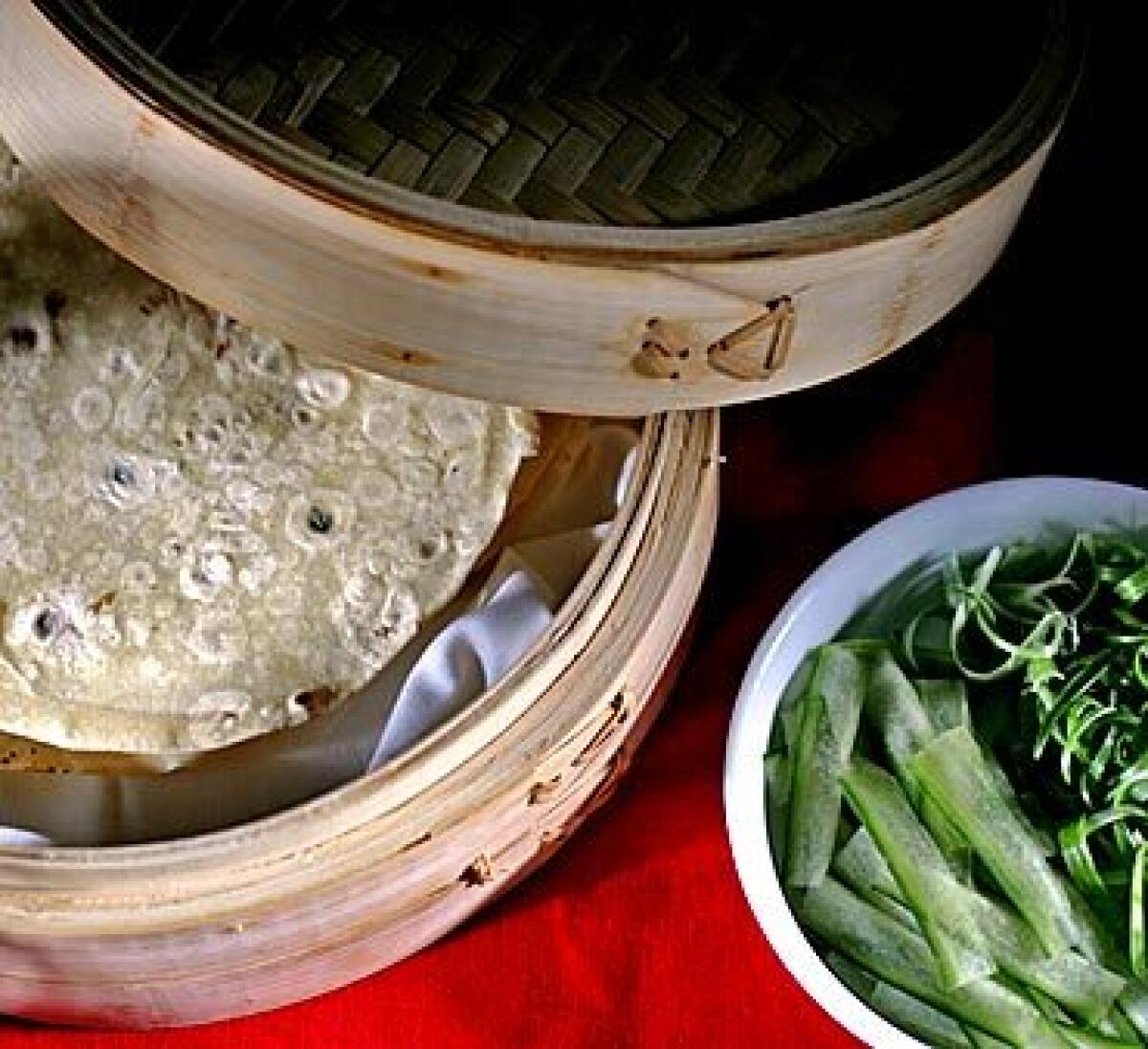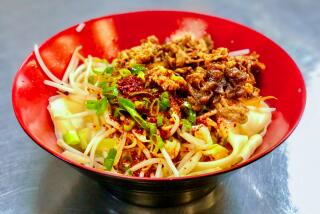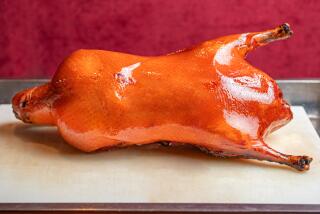Recipe: Mandarin pancakes

Mandarin pancakes
Total time: 50 minutes
Servings: Makes 12 to 14 (6 1/2 inch) pancakes
Note: Called bao bing in Mandarin, these thin pancakes are the classic accompaniment to Peking duck. Sandwiching the dough pieces and rolling them out in pairs produces translucent results. Skip the fancy flour and use a moderate gluten flour, such as Gold Medal brand, for toothsome pancakes. For the just-boiled water, bring water to boil, then let it calm down before measuring it out.
13/4 cups (71/2 ounces) flour, plus extra for dusting
Generous 1/4 teaspoon salt
About 1/2 cup just-boiled water
11/2 teaspoons plus 1 tablespoon canola or sesame oil, divided
1. To prepare the dough in a food processor, put the flour and salt in the processor. Combine the water and 1 1/2 teaspoons oil in a measuring cup. Run the machine, adding the liquid in a steady stream through the feed tube. After all the water has been added, let the machine run just until a ball of dough starts forming around the blade. Stop the machine, remove the dough and the scraggly bits. Give the soft dough a few turns on your work surface to form a relatively smooth ball; don’t overwork the dough.
Alternatively, make the dough by hand. Put a bowl atop a kitchen towel to prevent it from slipping while you work. Put the flour and salt in the bowl and make a well in the center. Use a wooden spoon or bamboo rice paddle to stir the flour while you add the water and 11/2 teaspoons oil in a steady stream. Aim to evenly moisten the flour and pause, as needed. Add extra water by the teaspoon if the dough seems dry. Give the dough a few turns on your work surface to form a relatively smooth ball; don’t overwork the dough.
2. Place the dough in a sealable plastic bag and seal tightly, expelling excess air. Set aside to rest at room temperature for at least 15 minutes and up to 2 hours.
3. Remove the dough from the bag and place on a floured work surface. Roll the dough out into a circle about one-fourth inch thick. Use a 21/2-inch round cookie cutter, dipping it in flour as needed, to cut out an even number of circles. (I usually cut 8 circles on this first pass.) Remove the scraps, gather them into a ball, give the ball a few light turns to make them stick together, then replace it in the plastic bag and seal.
4. To ensure that the pancakes will separate later, brush the top of each circle with some of the remaining 1 tablespoon of oil, making sure you go all way to the edge. Stack the circles in pairs, oiled sides facing each other.
5. Lightly dust both sides with flour, then roll each set into a very thin circle between 6 and 7 inches wide. Use the rolling pin to first press down on the midline of the dough to secure it in place; a little oil may leak out. Then, roll from the center out, frequently giving the dough a quarter turn to prevent sticking and create a round shape. If the dough sticks, sprinkle on a little flour. The result will resemble a thin flour tortilla. It’s OK if you do not produce a perfect round. Lightly flour the resulting set of pancakes and place on a parchment paper-lined baking sheet. It is fine to slightly overlap the rolled-out pancakes on the baking sheet.
6. When done with the first batch, roll out the scrap dough and repeat. (I get 4 circles on the second pass and 2 more with the remaining leftover scraps.) You can usually squeeze 1 pair of pancakes from the last bit of scraps; there’s no need to let the dough rest before you re-roll. If the pancakes shrink while they rest on the parchment, give each one a few passes of the rolling pin before cooking.
7. Preheat a medium skillet or large flat-bottomed wok over medium heat; both nonstick and regular cooking surfaces will work. To cook each set of pancakes, place in the skillet and cook until numerous bubbles appear, 40 to 60 seconds. Use a spatula or your fingers to flip the pancakes over. Let them cook for an additional 15 to 30 seconds, until more bubbles have formed. The dough may balloon up as steam gathers between the pancakes, and a few light brown spots may form. (Cooking each set of pancakes typically takes about 60 seconds in a thin skillet or wok and 90 seconds in a heavy skillet, such as an All-Clad or cast iron skillet.)
8. When done, the pancakes will be translucent. Lift them out of the skillet and drop or throw them down on the counter. Smacking the pancakes forces the steam out from between the layers, often creating an opening along the edge. Allow the pancakes to cool for about 30 seconds before peeling them apart. Stack the pancakes, fried side-down, in a folded-up dish towel, where they will soften and become pliable. Repeat until all the pancakes are cooked.
9. Keep the pancakes at room temperature if you are going to be using them right away. The pancakes can be refrigerated for up to 5 days; for less bulk, wrap them in parchment paper and keep in an airtight container. They can also be frozen for up to 2 months. Before using, return them to room temperature.
10. Serve the pancakes hot and refreshed. Over low heat, steam the stack of pancakes in a folded-over damp kitchen towel for about 15 minutes, until they are hot and pliable. (Put the steamer tray atop the pot of duck broth if it fits well.) Serve the pancakes from the steamer basket or fold each in quarters and arrange on a plate. Present alongside the Peking duck.
Each of 14 pancakes: 69 calories; 2 grams protein; 12 grams carbohydrates; 0 fiber; 2 grams fat; 0 saturated fat; 0 cholesterol; 0 sugar; 0 sodium.
More to Read
Eat your way across L.A.
Get our weekly Tasting Notes newsletter for reviews, news and more.
You may occasionally receive promotional content from the Los Angeles Times.










